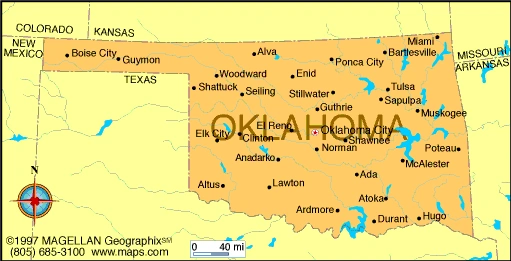Oklahoma City - geography.
Publié le 04/05/2013

Extrait du document

Oklahoma City - geography. Oklahoma City, city in central Oklahoma, lying on a level plain on both sides of the North Canadian River. It is the capital of the state and seat of Oklahoma County, and is also in Canadian, Cleveland, McClain, and Pottawatomie counties. In addition to being the seat of the state government, Oklahoma City is the state's principal financial, commercial, and transportation center. It is also a center for producing and refining crude petroleum, and working oil towers appear on the skyline in many areas of the city. Other manufactures include fabricated metal, aerospace and electronic equipment, cars, and tires. Cattle and wheat produced in the area are processed and shipped from the city. Nearby Tinker Air Force Base, a large aircraft supply and repair depot, is a major employer. The city is served by Will Rogers World Airport. Among the points of interest in Oklahoma City are the State Capitol, probably the only one in the world with a working oil well on its grounds; the National Cowboy Hall of Fame and Western Heritage Center; the National Softball Hall of Fame; the State Museum of History; and the Kirkpatrick Science and Air Space Museum at Omniplex. Enterprise Square, USA is an entertainment complex which aims to explain the American system of free enterprise with games and hands-on exhibits, such as a doughnut shop that teaches the law of supply and demand. The city is the site of Oklahoma City University (1904), the Health Sciences Center (established in 1910) of the University of Oklahoma, Oklahoma Christian University of Science and Arts (1950), and two junior colleges. Major annual events in the city are the Red Earth Festival, a celebration of Native American Arts, in June, and the large State Fair of Oklahoma, which begins in mid-September. From early times the Oklahoma City region was inhabited by Native Americans. In 1889 President Rutherford B. Hayes opened the area to settlement by whites with a famous land run for staking out claims. In a single day (April 22) a tent city of nearly 10,000 inhabitants sprang up at the site of the city. A railroad stop, opened in 1887, also encouraged settlement. Oklahoma City incorporated in 1890. By 1910, when Oklahoma City replaced Guthrie as the state capital, it was already the largest city in Oklahoma. It enjoyed great economic growth after productive oil and gas fields in and near the city were discovered in 1928. Subsequently, oil derricks, or towers, were built throughout the city, some situated on the lawns of private homes and near public buildings, notably the capitol. In the 1970s and 1980s the city center was renewed according to a plan drawn up in the early 1960s by Chinese American architect I. M. Pei. On April 19, 1995, Oklahoma City became the site of one of the most deadly terrorist attacks in the history of the United States. A massive bomb exploded in a truck in front of the Alfred P. Murrah Federal Building, killing 168 people, destroying much of the structure, and damaging many other buildings in the surrounding area. In 1997 Timothy McVeigh was found guilty of 11 counts of murder and conspiracy in connection with the bombing. He was sentenced to death and executed in 2001. Terry L. Nichols was convicted of conspiracy and involuntary manslaughter for his part in the attack. He was sentenced to life in prison. In the aftermath of the bombing, the city began work on a number of downtown redevelopment projects. A new stadium for the Triple A baseball team, the Oklahoma Redhawks, opened in 1998. Oklahoma City covers a land area of 1,572 sq km (607 sq mi), with a mean elevation of 365 m (1,197 ft). According to the 2000 census, whites are 68.4 percent of the population, blacks 15.4 percent, Asians 3.5 percent, Native Americans 3.5 percent, and Native Hawaiians and other Pacific Islanders 0.1 percent. The remainder are of mixed heritage or did not report race. Hispanics, who may be of any race, are 10.1 percent of the people. Population 403,213 (1980); 444,719 (1990); 506,132 (2000); 531,324 (2005 estimate). Microsoft ® Encarta ® 2009. © 1993-2008 Microsoft Corporation. All rights reserved.
Liens utiles
- Oklahoma City - geography.
- Cherry Don, 1936-1995, né à Oklahoma City, musicien américain.
- Buenos Aires (city) - geography.
- Dublin (city, Ireland) - geography.
- Mexico City - geography.









